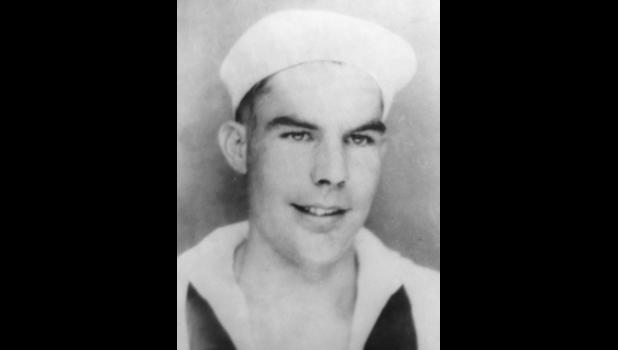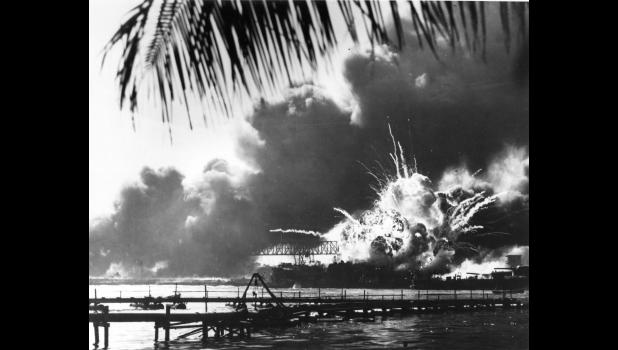Area sailor, killed at Pearl Harbor, home at last
By ANDREW MCGINN
Yet another veteran of World War II will be laid to rest Saturday in Glidden.
But what will make this funeral different than others taking place on the same day at the same time — an estimated 362 veterans of the war die every day — is the fact that this sailor’s death inspired an entire nation to take up arms and pick up rivet guns in the first place.
Navy Fireman 2nd Class George C. Ford was one of the 2,403 Americans killed by Japan’s surprise attack on Pearl Harbor on Dec. 7, 1941, and one of the first from west-central Iowa to make the ultimate sacrifice.
On Saturday morning, in a cruel twist of irony, he will be among the last area veterans of the Second World War to be buried.
The historic funeral will take place at 10:30 a.m. Saturday at Peace Lutheran Church in Glidden, with visitation at 9:30 a.m. and burial to follow in the Merle Hay Memorial Cemetery.
Ford will be buried with full military honors.
The Dahn & Woodhouse Funeral Home is in charge of arrangements.
A native of neighboring Carroll County, Ford was 24 when he was killed aboard the USS Oklahoma, one of seven battleships anchored in Pearl Harbor the fateful morning of Dec. 7.
It became a “date which will live in infamy” — but for 27,903 days afterward, his family couldn’t say with certainty that Ford was actually killed in the attack.
For 76 years, four months and 23 days, his remains were unable to be identified, buried with other “Unknowns” at the National Memorial Cemetery of the Pacific in Hawaii.
In May, the Defense POW/MIA Accounting Agency (DPAA) announced it had finally been able to identify Ford using DNA analysis.
Ford’s long journey home began in 2015, when DPAA exhumed all unknown remains from the cemetery in Honolulu known as the Punchbowl. In all, nearly 400 unidentified remains — many of them commingled — were buried in 46 plots at the cemetery, marooned for what seemed like an eternity by the shortcomings of science.
Ford, who was initially listed as missing in action after the attack, was presumed dead in 1942.
Now without a shadow of doubt, he was one of 429 men killed when the USS Oklahoma came under attack and capsized.
The mission of DPAA was profiled last year in The Jefferson Herald.
A.J. Tiffany, a 2000 graduate of Jefferson-Scranton High School and a career soldier in the Army, began a three-year assignment with DPAA in 2015, and spoke to the Herald about his work excavating sites on Guadalcanal and in Vietnam.
“It’s the credo of the military to leave no man behind,” Tiffany told the Herald in 2017. “It may take a year, it may take 75 years, but we will bring you home and bury you on American soil.”
Born the second-youngest of seven kids near Lidderdale on April 27, 1916, Ford enlisted in the Navy on Aug. 13, 1940, and reported for duty aboard the Oklahoma that October.
Moored in Battleship Row on Dec. 7, 1941, the Oklahoma made an easy target for the first wave of 181 Japanese planes, taking three torpedoes almost immediately.
Six more slammed into the Oklahoma as she began capsizing.
Within 20 minutes, the Oklahoma had turned turtle — it was almost entirely upside down.
The total attack lasted about two hours, but men trapped inside the Oklahoma’s hull could be heard pounding for help for more than three days.
By the time the last of the banging fell silent, the U.S. was at war with Japan, then Nazi Germany.
Among the men stepping up to serve was a former Jefferson kid named Darrell R. Lindsey, who enlisted as an aviation cadet on Jan. 16, 1942.
On Aug. 9, 1944, flying the lead B-26 on his 46th mission to destroy a heavily fortified railroad bridge over the Seine in France, Capt. Lindsey held his burning plane steady in order to drop its payload and then to ensure his crew could safely bail out.
He was never seen again.
For his courage under fire, Lindsey was awarded the Congressional Medal of Honor, but he remains listed as “missing in action” to this day, one of 1,331 Iowans still unaccounted for from World War II.
Lindsey undoubtedly made the ultimate sacrifice — but only luck and a little DNA will bring him home.
- Log in to post comments



